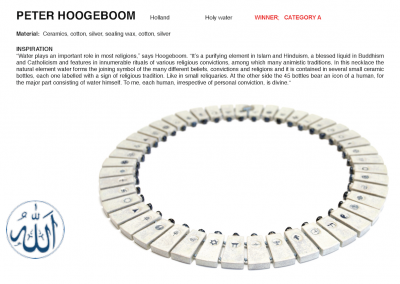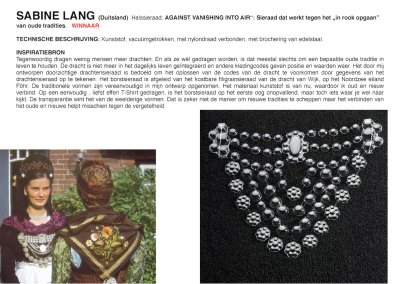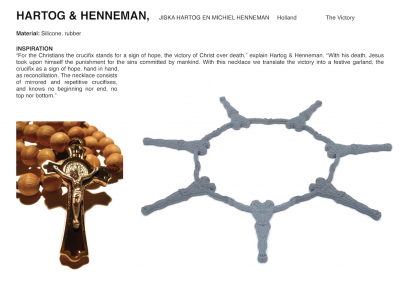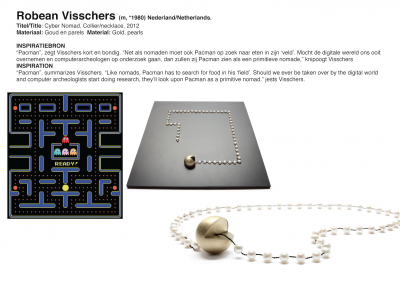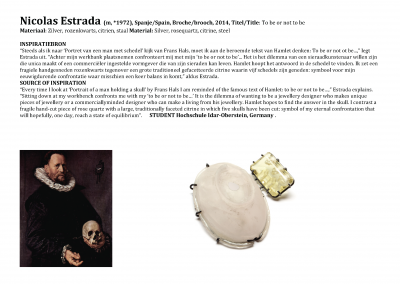2007 Symbols of Faith
The focus of the second edition of New Traditional Jewellery was on ‘Faith’. From times immemorial faith has been bound up with wearable images and objects with a special spiritual significance for the wearer. This may be a matter of faith in the sense of religion, but also of a non-organized and quite personal spirituality.
Well-known examples are rosaries, small reliquaries, crucifixes, charms of saints, amulets, portable holders of texts from the Koran, talismans of shamans and so on. But aren’t the big gold necklaces with symbols set in diamonds symbols of faith as well?
All this does not even begin to represent a complete list of the sources of inspiration that were the bases of all entries for this edition of NTJ. The shapes, materials and symbolism of jewellery that is connected with a religious conviction are just as diverse as of any other category of jewellery. The link between these ornaments is their purpose. Jewellery and ornaments, as aspects of a religion, were and are credited with active powers. Something is expected from these objects: the wearer must be protected, healed, become pregnant, rich or happy. It is the only category of jewellery that is supposed to actually do something for the wearer, other than just passively adorn or convey status. Jewellery based on faith or religion has never disappeared from the street scene. NTJ2007: Symbols of Faith has turned out to be a theme, a contest and an exhibition whose contents and quality of execution continue to appeal to the imagination.
Jury 2007:
Carin Reinders , dir. CODA Museum Apeldoorn
Fred W. Brom , F.G.A., Steltman juweler The Hague
Isabella van den Bos, collector
Astrid Berens, dir. SIERAAD Art Fair
Anne Berk , Art critic for Kunstbeeld and Het Financieële Dagblad
Charon Kransen , curator, dealer, vertegenwoordigt internationale hedendaagse sieraadontwerpers inde VS, dir. Charon Kransen Arts
Dinie Besems , designer
The central theme of the second edition of New Traditional Jewellery will be ‘faith’. Whichever way we look at it, be it in the sense of existing religions or non-organized spirituality, his faith reflects the way in which an individual views life, and this may be displayed in the form of a symbol worn on the body. What do you believe?
Religious jewellery and bearers of spiritual force boast a rich tradition, e.g. rosaries, small reliquaries containing remains of saints, crucifixes, medallions, all manifestations of Buddha, charms, prayer beads, amulets, special beads to ward off the Evil Eye. Then there are portable holders for texts from the Koran and other sacred writings; objects hanging from chains worn by witch doctors in Africa, Asia and by the American Indian tribes in the USA; strings of beads characteristic of the Condomblé religion of former slaves in South America, etc.
The shapes, materials and symbolism of these ornaments are diverse, but none of them are worn just for adornment or by way of status symbol. They all fulfil a clear function. On the one hand they are symbols bearing witness to someone’s belief (even if you are the only one to know its meaning). On the other hand they may be useful: the bearer must be protected, cursed, become pregnant, rich and happy. They are bearers of spiritual force charged with meaningful materials or rituals.
Symbols of faith or religion have never quite disappeared from the street scene. Secularization does not necessarily lead to a decrease in believers. In Western Europe a clear shift has been taking place from institutionalized religion (churches and communities) to a more individual interpretation. At the same time the institutionalization of Islam is on the increase. Usually we associate this religion with headscarves and terrorists, but it also boasts an extremely rich jewellery tradition.
Winners
IN THE CATEGORY OF ESTABLISHED ARTISTS THREE WINNERS HAVE BEEN SELECTED:




















